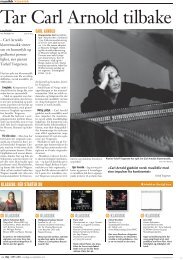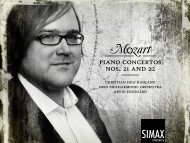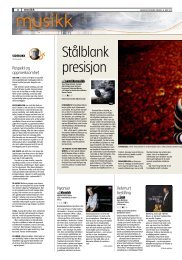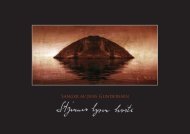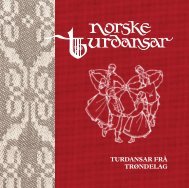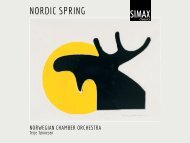J. S. BACH G. PH. TELEMANN 1B1 - Grappa Musikkforlag
J. S. BACH G. PH. TELEMANN 1B1 - Grappa Musikkforlag
J. S. BACH G. PH. TELEMANN 1B1 - Grappa Musikkforlag
You also want an ePaper? Increase the reach of your titles
YUMPU automatically turns print PDFs into web optimized ePapers that Google loves.
In Norwegian folk music, a very strong and diverse tradition, every valley has its own eccentricities of<br />
rhythmic and tonal deviations. As these subtleties can hardly be written down, such traditions are very<br />
vulnerable, and could easily face extinction. There are furious traditionalists who want to preserve<br />
traditions vigorously, not polluting them with modern varieties.<br />
This is reminiscent of the prohibition on bringing horses to Iceland, in order to keep the Icelandic breed<br />
genetically clean. (It sounds a bit scary, but these are animals.) However, this raises the question: what is<br />
a living tradition? Is preservation the same as keeping alive, or is it the opposite, mummification? Are<br />
transformation, eternal metamorphosis and mutations the sign of a living tradition?<br />
I think that authenticity, a word much abused, is the main hallmark of any genuine art, whether it be<br />
folklore or any other. The term has also been used frequently in the context of historically correct<br />
interpretation of Baroque scores. This is a movement in music that I feel has, to some extent, concluded<br />
by now. It started as a bit of a revolution, rebelling against the establishment. The first examples would<br />
often sound odd, maybe interesting, often rather horrible both instrumentally and artistically, but<br />
definitely DIFFERENT.<br />
Within a few decades, however, the level has risen, as pure “differentness” or a dry scientific approach<br />
have been merged with intuition and true artistry. Today, I feel this has become common knowledge and<br />
an instinct we all can use in our own ways. Certainly, the legacy of Bach is such a universal one, that it –<br />
certainly highly Baroque – also stands out of time, open to many approaches. This is further enhanced by<br />
the fact that many of his manuscripts have disappeared, and thereby many prime sources have become<br />
lost in the shadows of history.<br />
Somehow, with Bach, this seems no obstacle: his music lends itself to many interpretations, many<br />
versions. He himself recycled his own music and that of others, and it feels strongly authentic to live on<br />
in that tradition with his music.<br />
This does not mean that anything goes: it has to be done with knowledge, skill and love. This recording<br />
has certainly has been made with love, and we hope the underlying skill and knowledge may pass muster.<br />
Lars Anders Tomter<br />
4<br />
CONCERTOS BY<br />
J.S. <strong>BACH</strong> AND<br />
G. <strong>PH</strong>. <strong>TELEMANN</strong><br />
by Malcolm MacDonald<br />
Between about 1738 and 1742, in Leipzig, Johann<br />
Sebastian Bach produced 14 concertos for one or<br />
more harpsichords, writing out seven of the eight<br />
concertos for solo harpsichord as a set. Quite<br />
apart from their very high musical quality, these<br />
were epoch-making works in the full meaning of<br />
the term, for they virtually established a genre that<br />
had hardly existed up to that time in Germany,<br />
though it would afterwards become increasingly<br />
popular: namely the solo keyboard concerto. As a<br />
group, in fact, these concertos of Bach could<br />
claim to be the most significant and imposing<br />
keyboard concertos before the piano concertos of<br />
Mozart. All the same, we are not speaking here of<br />
works that anticipate the Classical concerto: the<br />
5<br />
division between soloist and orchestra (in fact, in<br />
Bach’s case there was no orchestra – the solo<br />
instrument was part of a chamber consort) are<br />
not used to create dialogue or drama, nor do the<br />
soloist and the accompanying instruments have<br />
different and distinct thematic material. Instead<br />
they remain thoroughly Baroque in their<br />
interpretation of the concerto genre, the soloists<br />
participating in the consort with busy and often<br />
brilliant figuration and regularly coming to the<br />
fore. The works follow a three-movement pattern<br />
of extrovert outer movements and slow, rapt<br />
central ones, and there is no extremity of<br />
virtuosity in the solo parts.




